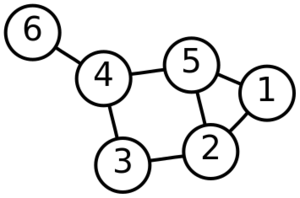Graph theory (nonfiction)
In mathematics, graph theory is the study of graphs, which are mathematical structures used to model pairwise relations between objects.
A graph in this context is made up of vertices, nodes, or points which are connected by edges, arcs, or lines. A graph may be undirected, meaning that there is no distinction between the two vertices associated with each edge, or its edges may be directed from one vertex to another
Graphs are one of the prime objects of study in discrete mathematics.
In the most common sense of the term, a graph is an ordered pair G = (V, E) comprising a set V of vertices or nodes or points together with a set E of edges or arcs or lines, which are 2-element subsets of V (i.e. an edge is associated with two vertices, and that association takes the form of the unordered pair comprising those two vertices). To avoid ambiguity, this type of graph may be described precisely as undirected and simple.
Other senses of graph stem from different conceptions of the edge set. In one more generalized notion, V is a set together with a relation of incidence that associates with each edge two vertices. In another generalized notion, E is a multiset of unordered pairs of (not necessarily distinct) vertices. Many authors call this type of object a multigraph or pseudograph.
The vertices belonging to an edge are called the ends or end vertices of the edge. A vertex may exist in a graph and not belong to an edge.
V and E are usually taken to be finite, and many of the well-known results are not true (or are rather different) for infinite graphs because many of the arguments fail in the infinite case. The order of a graph is |V|, its number of vertices. The size of a graph is |E|, its number of edges. The degree or valency of a vertex is the number of edges that connect to it, where an edge that connects a vertex to itself (a loop) is counted twice.
For an edge {x, y}, graph theorists usually use the somewhat shorter notation xy.
Graphs are useful in geometry and certain parts of topology such as knot theory.
Algebraic graph theory has close links with group theory.
A graph structure can be extended by assigning a weight to each edge of the graph. Graphs with weights, or weighted graphs, are used to represent structures in which pairwise connections have some numerical values. For example, if a graph represents a road network, the weights could represent the length of each road. There may be several weights associated with each edge, including distance (as in the previous example), travel time, or monetary cost. Such weighted graphs are commonly used to program GPS's, and travel-planning search engines that compare flight times and costs.
Graphs can be used to model many types of relations and processes in physical, biological, social and information systems. Many practical problems can be represented by graphs. Emphasizing their application to real-world systems, the term network is sometimes defined to mean a graph in which attributes (e.g. names) are associated with the nodes and/or edges.
In computer science, graphs are used to represent networks of communication, data organization, computational devices, the flow of computation, etc.
Graph-theoretic methods, in various forms, have proven particularly useful in linguistics, since natural language often lends itself well to discrete structure.
Graph theory is used to study molecules in chemistry and physics.
Graph theory is widely used in sociology as a way, for example, to measure actors' prestige or to explore rumor spreading, notably through the use of social network analysis software.
Graph theory is useful in biology and conservation efforts where a vertex can represent regions where certain species exist (or inhabit) and the edges represent migration paths or movement between the regions.
In the News
September 4, 1973: An experimental graph coloring model accidentally generates a Greedy coloring computer virus which causes the color green to become red in the vicinity of every computer terminal around the world. The virus will be eliminated several hours later by APTO troubleshooters, restoring green to its normal appearance.
Fiction cross-reference
Nonfiction cross-reference
External links:
- Graph theory @ Wikipedia

